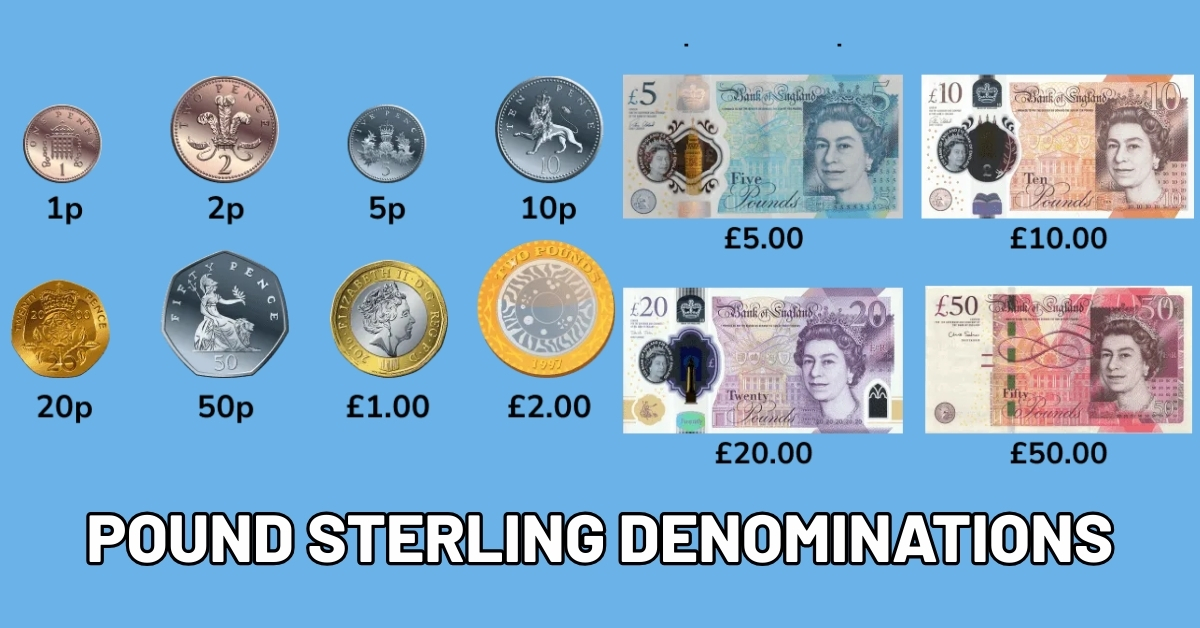The United Kingdom is a country in northwestern Europe. It is made up of four parts—England, Scotland, Wales, and Northern Ireland. The UK is surrounded by water. It lies between the North Atlantic Ocean and the North Sea. It also shares a land border with Ireland. The land is a mix of mountains, hills, and flat plains. The highest point is Ben Nevis in Scotland. The longest river is the River Severn. The UK is renowned for its rich history, royal family, and iconic landmarks, including Big Ben and Buckingham Palace.
But here's something you might not know: what currency does the UK use? It's not the euro, even though many European countries use it. Curious? In this article, we'll take a look at the currency of the United Kingdom, its name, its history, and why it's still used today.
Currency of the United Kingdom
The currency of the United Kingdom and nine of its associated territories is the pound sterling (£), commonly referred to as GBP. The pound is the primary unit of sterling, and the term "pound" is often used to denote the British currency in general. In international contexts, it is frequently specified as the British pound or pound sterling.
What is the history of the currency in the UK?
The UK's currency, the pound sterling (£), has a long and complex history. It is one of the oldest currencies still in use today:
Origins and Early Pounds
- Anglo-Saxon Era (c. 760 AD): The pound sterling's origins trace back to this period. It was not a physical coin but a unit of account. A "pound" was equivalent to the value of 240 silver pennies, which were minted from a pound of sterling silver.
- The £sd System: This pre-decimal system of pounds, shillings, and pence, with the symbols £, s, and d, was used for centuries. These symbols came from the Latin words 'libra' (pound), 'solidus' (shilling), and 'denarius' (penny), respectively.
- First Pound Coin (1489): The first pound coin, a gold sovereign, was introduced during the reign of King Henry VII. This was a significant step toward making the pound a physical currency.
The Bank of England and the Gold Standard
- Banknotes Emerge (1694): The Bank of England was established and began issuing banknotes, which were handwritten initially. This marked the beginning of paper money in the UK.
- Gold Standard (1717): Under the guidance of Isaac Newton, who was Master of the Mint, the UK fixed the value of the pound sterling in relation to gold. The official gold standard was adopted in the 19th century, providing stability and helping the pound become a primary global currency.
- Suspension of the Gold Standard (1931): The gold standard was permanently abandoned during the Great Depression. The pound then became a fiat currency, meaning its value was no longer tied to a physical commodity but was determined by the UK's economic health and market forces.
Decimalisation Day
- The Old System's Complexity: Before 1971, the currency system was unwieldy. A pound was 20 shillings, and a shilling was 12 pence, meaning there were 240 pennies to the pound. This made calculations difficult.
- Decimal Day (15 February 1971): This was a significant event in UK history. The country officially switched to a decimal currency system. The pound remained, but it was now divided into 100 "new pence".
- Public Adaptation: The change was promoted with a significant public information campaign. New coins like the 5p and 10p were introduced before the official date to help the public get used to the new system.
Modern Era and European Union
- No to the Euro: Although the UK was a member of the European Union, it chose to retain the pound sterling and not adopt the euro, citing the importance of controlling its own monetary policy.
- Brexit's Impact: The 2016 vote to leave the European Union led to a significant decline in the pound's value, which fluctuated in response to ongoing trade negotiations and other developments.
- Current Denominations: Today, the UK currency consists of coins in denominations of 1p, 2p, 5p, 10p, 20p, 50p, £1, and £2, as well as banknotes for £5, £10, £20, and £50. The pound sterling remains one of the world's most-traded currencies.
What are the denominations of GBP?

The official currency of the United Kingdom is the pound sterling (£), and it is divided into 100 pence (p). Here are the denominations of British currency currently in circulation:
Coins
- 1 penny (1p)
- 2 pence (2p)
- 5 pence (5p)
- 10 pence (10p)
- 20 pence (20p)
- 50 pence (50p)
- £1 (one pound)
- £2 (two pounds)
Banknotes
- £5 (five pounds)
- £10 (ten pounds)
- £20 (twenty pounds)
- £50 (fifty pounds)
As of September 2025, 1 pound sterling is equal to ₹119.32.
Comments
All Comments (0)
Join the conversation